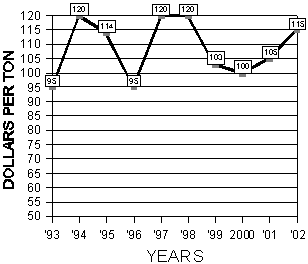Alfalfa Report
Yuma County, Arizona
February 25, 2002
Yuma County Office
2200 W. 28th Street, Ste. 102
Yuma, AZ 85364
(928) 726-3904
(928) 726-8472 FAX
Production Update:
PDF version, 58KB
Hay Preservatives (Part 3): Microbial hay preservatives or inoculants are available in addition to chemical preservatives. Microbial preservatives are not corrosive to equipment, as is the case with most chemical preservatives, and may be naturally occurring and derived from hay. The beneficial bacteria in hay inoculants stabilize high moisture hay and prevent heating, mold growth, and dry weight loss caused by harmful microbes.
Insect Management: Empoasca spp. leafhopper (potato
leafhopper photo) occasionally infest low desert alfalfa in large
enough numbers to cause economic damage. These tiny yellowish-green insects
cause a characteristic wedge-shaped yellow area on the outer end of leaflets
(
photo
of damage). The leafhoppers inject salivary toxins that cause the
yellowing and stunting. When unabated, the yellowing spreads over the
entire leaf giving the field a yellowish appearance. Leafhopper populations
build in vegetable fields and weeds. Adult leafhoppers then migrate to
alfalfa. If damaging infestations are not controlled, the toxin levels
in the crown may persist to stunt and yellow subsequent cuttings. The
treatment threshold is 5 to 10 leafhoppers per sweep.
Weed Control: Roundup Ready alfalfa is being developed by Monsanto.
Tests being conducted in this area indicate that alfalfa with this genetic
characteristic has excellent tolerance to Roundup. The varieties have
not yet been chosen and the rates and seed cost have not been finalized.
Registration is currently projected at 2004.
| Market Summary |
High
|
Low
|
Average
|
Off grade
|
| Past 2 Weeks (Feb 12, 2002 - Feb 24, 2002) |
120
|
105
|
115
|
90-100
|
| Last Year (Feb 12, 2001 - Feb 24, 2001) |
110
|
95
|
105
|
70-90
|
10 Year Summary (February 12, to February 24, 1993 - 2002):

Issued in furtherance of Cooperative Extension work, acts of May 8 and June 30, 1914, in cooperation with the U.S. Department of Agriculture, James A. Christenson, Director Cooperative Extension, College of Agriculture and Life Sciences, The University of Arizona.
The University of Arizona is an equal opportunity, affirmative action institution. The University does not discriminate on the basis of race, color, religion, sex, national origin, age, disability, veteran status, or sexual orientation in its programs and activities.
Any products, services, or organizations that are
mentioned, shown, or indirectly implied in this web document do not imply
endorsement by The University of Arizona.
Information provided by:
Barry Tickes, btickes@ag.arizona.edu Extension Agent, Yuma County
Michael Ottman, mottman@ag.arizona.edu Agronomy Specialist
College of Agriculture, The University of Arizona.
Eric Natwick, etnatwick@ucdavis.edu UCCE Imperial County - Farm Advisor
University of California, Davis, CA.
Forages: Crop Mgmt | Soil Mgmt | Irrigation | Alfalfa Reports | Insects | Diseases | Weeds | Pesticides
Home | Other Crops | Forages
For more Arizona Production Ag Information:
Home | Cotton | Veggies| Forages | Grains | Citrus | Crop x Crop | Insects | Diseases| Weeds | Pesticides | News | Weather | Research | Photos | Contacts | General Info. | Site Map
Copyright © 2001 University of Arizona,
College of Agriculture and Life Sciences
Webmaster: Al Fournier (fournier@ag.arizona.edu)